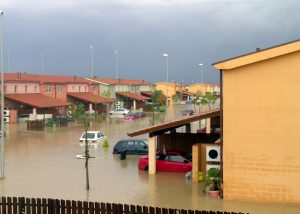 What’s the #1 natural disaster in the U.S.? It might surprise you to know, but it isn’t earthquakes or a tornado. It’s flooding.
What’s the #1 natural disaster in the U.S.? It might surprise you to know, but it isn’t earthquakes or a tornado. It’s flooding.
Every state in the country has experienced flooding or a flash flood in recent years.
However, in spite of this, homeowners’ insurance policies don’t come with flood insurance built-in. If you want coverage, you have to buy flood insurance separately.
If you’re like most folks, you’re looking to save on your monthly bill and may consider not adding flood insurance to your policy. After all, it isn’t always necessary and you don’t want to be throwing money away. But you should know the risks before making your decision.
Continue reading to learn about the telltale signs that indicate you should get flood insurance.
Why Should I Buy Flood Insurance?
A mere inch of water can cost $27,000 worth of damage to your home. You may think you can just dry everything out and call it good, but that’s difficult.
Your carpet will not be the same color once the waters recede and even a professional cleaning may not be enough to restore it. Plus, floodwaters are dirty and full of harmful bacteria and pathogens. It can be difficult to thoroughly clean all the nastiness that gets trapped down in the carpet fibers.
It’s also difficult to fully dry a carpet out after a flood. The pad underneath is soaked and it’s nearly impossible to remove all the water.
To thoroughly clean and dry your carpet, you’ll probably need to replace it. If you don’t, you’re exposing yourself and your family to serious health risks since mold and mildew can grow in and under your carpet.
And that’s just the floor.
Now imagine the effects on the walls if your home is flooded with more than an inch or two of water.
Never been the victim of a flood in the Houston area? Count your blessings. However, chances are you are probably in an X zone for flooding, and if so you are entitled to the least expensive insurance from FEMA for flood. Since we don’t know what the future will bring, paying a very low yearly premium can give you peace of mind, and cover your home and contents in case you are not so lucky during the next hurricane or flood threat.
Let’s look at some signs to help you determine if you need to buy flood insurance for your home.
1. Your House Is in a Flood Zone
Many people don’t realize their homes are in a flood zone. Unless you knew what to look for when reading your real estate paperwork, or specifically asked, it’s possible you bought the home without ever knowing or being informed that it’s in a flood zone.
To check, simply get out that nice thick stack of real estate paperwork and search for the “Natural Hazards Disclosures” section. If your home is in a flood zone as designated by the Federal Emergency Management Agency, it will be listed as being in either “Zone A” or “Zone B”.
What if you don’t have your paperwork or think that it may not be accurate or complete? Where do you go to find out this information?
Head down to your local post office or the county assessor’s office. In either of these offices, you can ask to see a list of all the local parcels that fall into either of those two categories.
If your parcel is listed, buying flood insurance is strongly advised and may be required. Your home is considered to be at high-risk for flooding.
The easiest way though, is to call your local insurance agent and have them give you a quote. They will be able to tell you if you are in a flood zone, how much the coverage will be, and if there is anything you can do to make the coverage less expensive.
2. Your Mortgage Lender Requires it
If you borrow money to buy your home, the lender may require you to purchase flood insurance. The government mandates any lender that is regulated or insured by the government to require flood insurance if the property is in a high-risk area.
3. You’ve Received Disaster Assistance
In areas where a Presidential Disaster Declaration is made, home and business owners are eligible to receive disaster aid from the government. This can come in the form of FEMA grants or low-interest loans from the Small Business Administration.
Have you received this type of assistance and live in a high-risk flood area? In order to maintain your eligibility for disaster assistance in the future, you’ll likely be required to buy flood insurance.
4. Your Area Has a History of Flooding
Official paperwork is always a great source, but don’t forget about talking to the neighbors. Long-time residents can provide a wealth of information about the area’s flood history. This is especially helpful when you have reason to believe that the paperwork regarding your home is incorrect.
5. Your Home Is Near Water
This might seem obvious, but sources of water aren’t always as obvious as you’d think. Take some time to inspect the surrounding area to determine if your home is at risk from nearby water.
Plot maps of the area will typically show blue lines to indicate the presence of streams — both seasonal and year-round ones. If your home is at a lower elevation than – or downstream from – a flowing source of water, it may be at risk of flooding during a storm.
Other not so obvious sources of water include neighboring pools. Natural disasters can strike hard enough to send your neighbor’s summertime backyard delight pouring into your living room.
Pro tip: check out satellite images from local real estate websites to find homes with hidden pools in their backyards.
To Buy or Not to Buy Flood Insurance?
Whether you need to buy flood insurance is completely dependent on the location of your property. Here we’ve offered several signs and tips for how to determine the risk in your area.
Are you interested in finding out how much it will cost to supplement your homeowner’s insurance in Texas with flood insurance? Reach out to us for an instant quote today. We’ll be happy to help you understand everything you need to know about flood insurance and whether it’s something you need to buy. Keep in mind that there is a 30 day waiting period, so getting coverage a few days before an expected hurricane won’t cut it – you won’t be covered until 30 days after you get the coverage.
